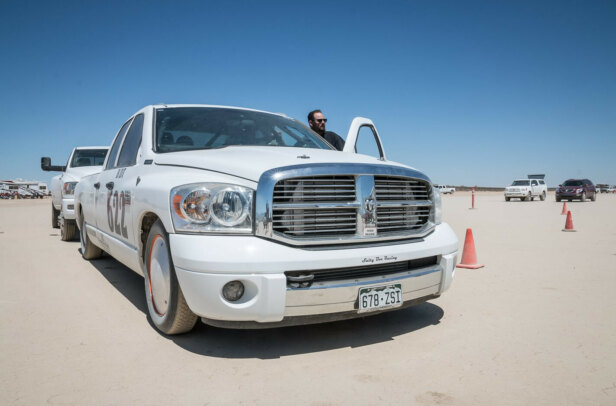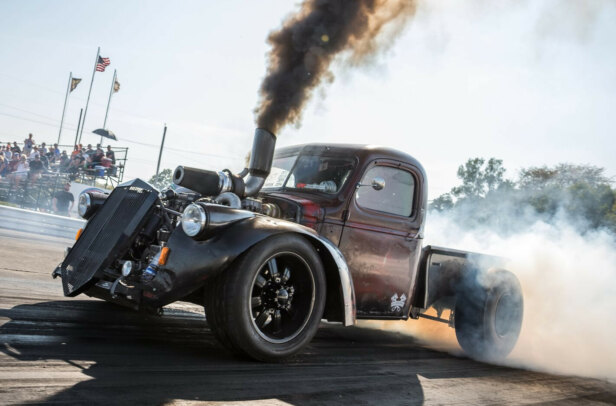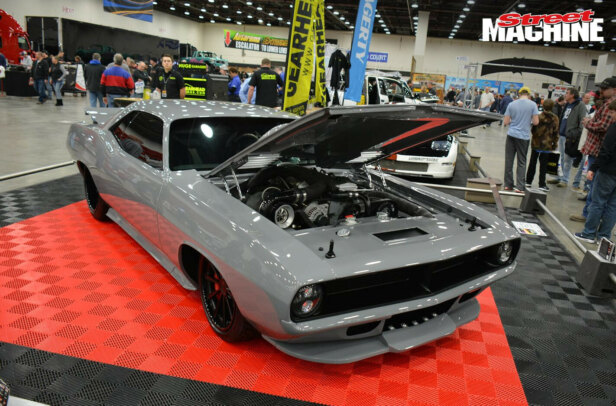Diesel-powered rigs are not commonplace in these pages, but Reece Wooldridge’s Dodge Ram is such a bad-arse we had to feature it. This all-wheel-drive monster is a real standout, and I’m not just talking about the paintjob. Under the hood lurks a 5.7-litre Hamilton/Cummins diesel mill with a solid block and water-cooled head, capable of absorbing 100psi of boost. The Dodge had already run an 8.80 quarter-mile with a previous combo, and the truck’s new mill is set to better that.
First published in the September 2023 issue of Street Machine




“I’ve always been in love with trucks,” Reece says. “I started with Land Cruisers when I was younger and got heavily involved in four-wheel driving. Back then, everyone had a lift kit and the Leyland Brothers were still a big thing.
“I slammed a 5.7-litre Gen 3 in a 60-series back in 1997 and remember heading to Fraser Island with it. Let me tell you, that was something different to everyone else’s car! I ended up buying a Dodge Ram as a tow vehicle, and that’s when I became addicted to diesel power.”



Reece started looking around for something to modify a few years back and ended up buying this 4WD Ram in South Carolina. He was lucky enough to have a good buddy, Drew, living in Florida, who was willing to help with the build in the US.
The idea was to build a 10-second, full-weight drag truck, but that plan started going out the window as soon as the full rollcage went in. The Ram then went on a diet, getting stripped of the sound deadener on the floor and the interior trim; even the steel pick-up bed was ditched for a fibreglass replacement. Even in gutted trim and without a driver, the big Dodge still tips the scales at over 2.5 tons (2.27 metric tonnes), with a full steel chassis and big Dana diffs front and rear.

“I was involved in the build as much as you can be from the other side of the world; I had a shop in the States doing a lot of the work and sourced a lot of the engine components from D&J Precision Machine in Indianapolis,” Reece says. “My buddy Drew rebuilt the 5.9L, 12-valve Cummins 6BT motor with a bunch of good parts, which we tested to 1500hp.”
Under the hood lurks a 5.7L Hamilton/Cummins diesel mill with a solid block and water-cooled head, capable of absorbing 100psi of boost
Reece reached out to SunCoast Diesel in Florida to supply a competition version of the factory 48RE transmission with one of the company’s diesel competition converters. This worked out great initially, but as they developed the engine further and leaned on it, the trans required servicing, which became a challenge, as it’s a fully welded unit.

“We finally got it all together and ran it in the United States, where we managed an 8.8@155mph – way better than our expectations,” Reece says.
That said, the engine tuner was leaning on it hard and they ended up cooking a piston, which brought them to a new motor combination. Drew sourced a solid block and transferred a lot of parts over, along with sourcing new, high-end Cummins parts including a Stage Four cylinder head.
“We ditched the factory ‘P’ pump early in development and went to dual CP3 10mm stroker injection pumps from Fleece Performance Engineering,” Reece explains. “One is driven off the camshaft in the standard location, and the other is belt-driven off the front of the motor.”


The stock exhaust manifold was also upgraded to a full stainless-steel item with an 85mm GT55 turbo pushing 65-80psi of boost.
“The old tuner was really leaning hard on the previous combination to run the 8.8; it was on the ragged edge,” Reece says. “So we brought the Ram back to Australia to continue with its development.
With a 1600hp tune-up currently in the Ram, it’s just a matter of track time and focusing on chipping away at the 1.55-second 60-foot
“Over the past four years, there have been a lot of changes in tuning methods for diesel engines, and there are essentially two styles: run the engine with an exhaust temperature under 1800°F with high boost, or run lower boost [under 80psi] with exhaust temperatures between 1800°F and 2000°F,” Reece continues. “Ryan Milliken from Hardway Performance in Florida is now our tuner and we run with the second method. The only downside of running the motor a little hotter is you need to change the exhaust valves every year, which is no big deal.”

Despite the new engine being a little smaller at 5.7 litres, Reece upped the turbo to an 88, which meant getting it up on boost initially presented another challenge. To help things along, the MoTeC ECU controls a three-stage nitrous system that uses a 52thou jet plumbed in the intake to get the truck up on the transbrake, then an additional 88thou jet sprays when it leaves the startline. Two seconds in, another 110thou jet is activated.
There is a lot going on at the startline; the rear air locker also gets activated, and until recently the trans was manually shifted, but Reece has just upgraded to an air shifter system controlled by the MoTeC.

“We are slowly creeping up on the tune-up,” Reece says. “We have made a lot of changes to suit the new motor, like the bolt-together converter, which allows us to service it ourselves rather than the big cost and delays in sending it back to the States for changes.
“Right now, 9.2 and 149mph are our quickest ET and mph [with the new combo], and we are struggling hard with traction issues. Yes, the Ram is 4WD and we do have a locker in the front diff, but we don’t use it, as having lockers front and rear is a recipe for disaster!”

With a 1600hp tune-up currently in the Ram, it’s just a matter of track time and focusing on chipping away at the 1.55-second 60-foot.
From an engineering standpoint, every inch of the truck is superbly built and presented. Even rolling on the big Hoosier slicks, the enormous torque that the 6BT produces makes the truck a handful. Thankfully, Reece has a great team helping him with this rig, and watching it haul down the track is quite spectacular. Stay tuned for more on its development!



Comments